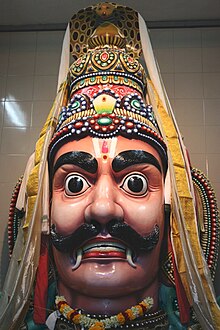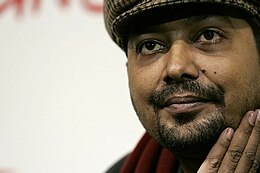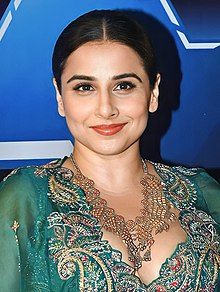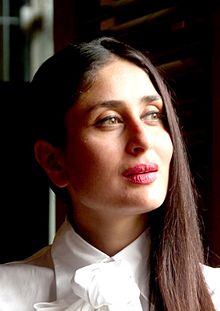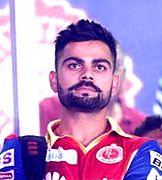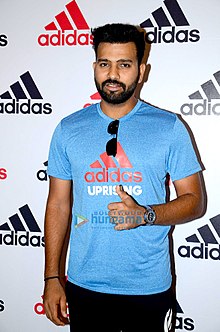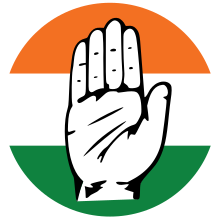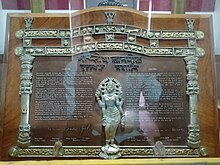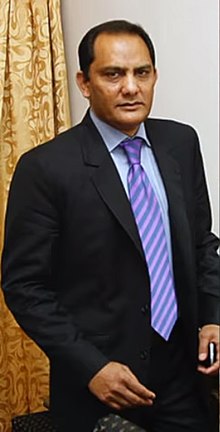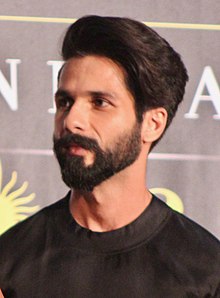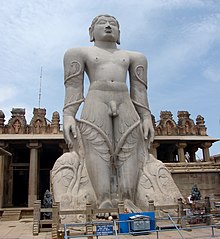Portal:India
Introduction

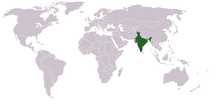
India, officially the Republic of India (ISO: Bhārat Gaṇarājya), is a country in South Asia. It is the seventh-largest country by area; the most populous country as of June 2023; and from the time of its independence in 1947, the world's most populous democracy. Bounded by the Indian Ocean on the south, the Arabian Sea on the southwest, and the Bay of Bengal on the southeast, it shares land borders with Pakistan to the west; China, Nepal, and Bhutan to the north; and Bangladesh and Myanmar to the east. In the Indian Ocean, India is in the vicinity of Sri Lanka and the Maldives; its Andaman and Nicobar Islands share a maritime border with Thailand, Myanmar, and Indonesia. (Full article...)
Selected pictures
The 1990 Andhra Pradesh cyclone was the worst disaster to affect Southern India since the 1977 Andhra Pradesh cyclone. The system was first noted as a depression on 4 May 1990, while it was located over the Bay of Bengal about 600 km (375 mi) to the southeast of Chennai, India. During the next day the depression intensified into a cyclonic storm and started to intensify rapidly, becoming a super cyclonic storm early on 8 May. The cyclone weakened slightly before it made landfall on India about 300 km (190 mi) to the north of Madras in the Andhra Pradesh state as a very severe cyclonic storm with winds of 165 km/h (105 mph). While over land the cyclone gradually dissipated. The cyclone had a severe impact on India, with over 967 people reported to have been killed. Over 100,000 animals also died in the cyclone with the total cost of damages to crops estimated at over $600 million (1990 USD). (Full article...)
Bhikshatana (Sanskrit: भिक्षाटन; Bhikṣāṭana; literally, "wandering about for alms, mendicancy") or Bhikshatana-murti (Bhikṣāṭanamūrti) is an aspect of the Hindu god Shiva as the "Supreme mendicant" or the "Supreme Beggar". Bhikshtana is depicted as a nude four-armed man adorned with ornaments who holds a begging bowl in his hand and is followed by demonic attendants and love-sick women.
Bhikshatana is considered a gentler form of Shiva's fierce aspect Bhairava and a gentle phase between Bhairava's two gruesome forms, one of which decapitates one head of the four headed god Brahma and the other of which kills the god Vishnu's gatekeeper. Bhikshatana is the form of Bhairava that Shiva assumes to atone for his sin of severing Brahma's fifth head. He wanders the universe in the form of a naked Kapali mendicant, begging for alms with Brahma's kapala (skullcup) as his begging bowl, until his sin is expiated upon reaching the holy city of Varanasi. (Full article...)
Manek Pallon Bajana (14 September 1886 – 28 April 1927) was an Indian amateur cricketer who played 55 first-class cricket matches between 1911 and 1920. Originally a member of the Indian team which toured England in 1911, he remained in the country and joined Somerset County Cricket Club, for which he played as an opening batsman until 1920. During his nine-year first-class cricket career, Bajana scored 1,975 runs at an average of 20.78. He scored three centuries, and made his highest score in 1920, scoring 115 runs against Cambridge University. (Full article...)
Prayagraj (ISO: Prayāgarāja; /ˈpreɪəˌɡrɑːdʒ, ˈpraɪə-/), formerly known as Allahabad or Ilahabad, is a metropolis in the Indian state of Uttar Pradesh. It is the administrative headquarters of the Prayagraj district, the most populous district in the state and 13th most populous district in India and the Prayagraj division. The city is the judicial capital of Uttar Pradesh with the Allahabad High Court being the highest judicial body in the state. Prayagraj is the seventh most populous city in the state, thirteenth in Northern India and thirty-sixth in India, with an estimated population of 1.53 million in the city. In 2011, it was ranked the world's 40th fastest-growing city. The city, in 2016, was also ranked the third most liveable urban agglomeration in the state (after Noida and Lucknow) and sixteenth in the country. Hindi is the most widely spoken language in the city.
Prayagraj lies close to Triveni Sangam, the "three-river confluence" of the Ganges, Yamuna, and the mythical Sarasvati. It plays a central role in Hindu scriptures. The city finds its earliest reference as one of the world's oldest known cities in Hindu texts and has been venerated as the holy city of Prayāga in the ancient Vedas. Prayagraj was also known as Kosambi in the late Vedic period, named by the Kuru rulers of Hastinapur, who developed it as their capital. Kosambi was one of the greatest cities in India from the late Vedic period until the end of the Maurya Empire, with occupation continuing until the Gupta Empire. Since then, the city has been a political, cultural and administrative centre of the Doab region. (Full article...)
The demolition of the Babri Masjid was carried out on 6 December 1992 by a large group of activists of the Vishva Hindu Parishad and allied organisations. The 16th-century Babri Masjid in the city of Ayodhya, in Uttar Pradesh, India, had been the subject of a lengthy socio-political dispute, and was targeted after a political rally organised by Hindu nationalist organisations turned violent.
In Hindu tradition, the city of Ayodhya is the birthplace of Rama. In the 16th century a Mughal commander, Mir Baqi, had built a mosque, known as the Babri Masjid at a site identified by some Hindus as Ram Janmabhoomi, or the birthplace of Rama. The Archaeological Survey of India states that the mosque was built on land where a non-Islamic structure had previously existed. In the 1980s, the Vishva Hindu Parishad (VHP) began a campaign for the construction of a temple dedicated to Rama at the site, with the Bharatiya Janata Party (BJP) as its political voice. Several rallies and marches were held as a part of this movement, including the Ram Rath Yatra led by L. K. Advani. (Full article...)
Producers Graham Broadbent and Peter Czernin first saw the potential for a film in Deborah Moggach's novel with the idea of exploring the lives of the elderly beyond what one would expect of their age group. With the assistance of screenwriter Ol Parker, they came up with a script in which they take the older characters completely out of their element and involve them in a romantic comedy. (Full article...)
Alibabavum 40 Thirudargalum was shot in Gevacolor and is notable for being the first Tamil and South Indian full-length colour film. It is a remake of the 1954 Hindi film Alibaba Aur 40 Chor, itself based on the story Ali Baba and the Forty Thieves from One Thousand and One Nights. It is also the second Tamil film adaptation of that story, after the 1941 film of the same name. Filming took place mainly at Mysore and Yercaud. The soundtrack was composed by Susarla Dakshinamurthi, and re-used many songs from Alibaba Aur 40 Chor. (Full article...)

Kerala (English: /ˈkɛrələ/ KERR-ə-lə), called Keralam in Malayalam (Malayalam: [keːɾɐɭɐm] ⓘ), is a state on the Malabar Coast of India. It was formed on 1 November 1956, following the passage of the States Reorganisation Act, by combining Malayalam-speaking regions of the erstwhile regions of Cochin, Malabar, South Canara, and Travancore. Spread over 38,863 km2 (15,005 sq mi), Kerala is the 21st largest Indian state by area. It is bordered by Karnataka to the north and northeast, Tamil Nadu to the east and south, and the Lakshadweep Sea to the west. With 33 million inhabitants as per the 2011 census, Kerala is the 13th-largest Indian state by population. It is divided into 14 districts with the capital being Thiruvananthapuram. Malayalam is the most widely spoken language and is also the official language of the state.
The Chera dynasty was the first prominent kingdom based in Kerala. The Ay kingdom in the deep south and the Ezhimala kingdom in the north formed the other kingdoms in the early years of the Common Era (CE). The region had been a prominent spice exporter since 3000 BCE. The region's prominence in trade was noted in the works of Pliny as well as the Periplus around 100 CE. In the 15th century, the spice trade attracted Portuguese traders to Kerala, and paved the way for European colonisation of India. At the time of Indian independence movement in the early 20th century, there were two major princely states in Kerala: Travancore and Cochin. They united to form the state of Thiru-Kochi in 1949. The Malabar region, in the northern part of Kerala, had been a part of the Madras province of British India, which later became a part of the Madras State post-independence. After the States Reorganisation Act, 1956, the modern-day state of Kerala was formed by merging the Malabar district of Madras State (excluding Gudalur taluk of Nilgiris district, Lakshadweep Islands, Topslip, the Attappadi Forest east of Anakatti), the taluk of Kasaragod (now Kasaragod District) in South Canara, and the erstwhile state of Thiru-Kochi (excluding four southern taluks of Kanyakumari district, and Shenkottai taluks). (Full article...)

Football was first introduced as an Olympic sports at the Summer Olympic Games held in France in 1900. It was played by only three club teams from three nations as an exhibition sport and played again at the 1904 Games. National sides played for the first time at the 1908 Summer Olympics. India did not send a football side to the Olympics until the 1948 Games; it participated in the next three Games. An Indian team last participated in the 1960 Games. India's best appearance was at the 1956 Summer Olympics where its team reached the semi-finals. Beginning with the 1992 Summer Olympics, the rules were changed so that only under-23 national teams are allowed to compete in the Games. India's U-23 national team has yet to qualify for the Olympic football competition. (Full article...)
Sir Chandrasekhara Venkata Raman FRS (/ˈrɑːmən/; 7 November 1888 – 21 November 1970) was an Indian physicist known for his work in the field of light scattering. Using a spectrograph that he developed, he and his student K. S. Krishnan discovered that when light traverses a transparent material, the deflected light changes its wavelength and frequency. This phenomenon, a hitherto unknown type of scattering of light, which they called "modified scattering" was subsequently termed the Raman effect or Raman scattering. Raman received the 1930 Nobel Prize in Physics for the discovery and was the first Asian to receive a Nobel Prize in any branch of science.
Born to Tamil Brahmin parents, Raman was a precocious child, completing his secondary and higher secondary education from St Aloysius' Anglo-Indian High School at the age of 11 and 13, respectively. He topped the bachelor's degree examination of the University of Madras with honours in physics from Presidency College at age 16. His first research paper, on diffraction of light, was published in 1906 while he was still a graduate student. The next year he obtained a master's degree. He joined the Indian Finance Service in Calcutta as Assistant Accountant General at age 19. There he became acquainted with the Indian Association for the Cultivation of Science (IACS), the first research institute in India, which allowed him to carry out independent research and where he made his major contributions in acoustics and optics. (Full article...)
Bhakta Prahlada (transl. Devotee Prahlada) is a 1932 Indian Telugu-language Hindu mythological film directed by H. M. Reddy and produced by Ardeshir Irani of Imperial Film Company. It is the first sound film of Telugu cinema. It features Sindhoori Krishna Rao as the titular Prahlada, along with Munipalle Subbayya, Surabhi Kamalabai, Doraswamy Naidu, Chitrapu Narasimha Rao, and L. V. Prasad. No complete synopsis of the film is known to survive, but it is an adaptation of a play of the same name.
Having achieved success in Hindi cinema by releasing India's first sound film Alam Ara in 1931, Irani wanted to expand his scope to South Indian cinema. Bhakta Prahlada was released on 6 February 1932, and was positively received by the audience but variedly by critics, who panned its resemblance to the stage version, poor sound recording, and low-quality images. It is now lost; surviving artefacts include a few stills, advertisements, and reviews. (Full article...)
Swaminarayan (IAST: Svāmīnārāyaṇa; 3 April 1781 – 1 June 1830), also known as Sahajanand Swami, was a yogi and ascetic believed by followers to be a manifestation of Krishna or the highest manifestation of Purushottama, around whom the Swaminarayan Sampradaya developed.
In 1800, he was initiated into the Uddhava sampradaya by his guru, Swami Ramanand, and was given the name Sahajanand Swami. Despite opposition, in 1802, Ramanand handed over the leadership of the Uddhava Sampradaya to him before his death. According to the Swaminarayan tradition, Sahajanand Swami became known as Swaminarayan, and the Uddhava Sampradaya became known as the Swaminarayan Sampradaya, after a gathering in which he taught the Swaminarayan Mantra to his followers. (Full article...)
The song was Harrison's only composition on Sgt. Pepper, although his endorsement of Indian culture was further reflected in the inclusion of yogis such as Paramahansa Yogananda among the crowd depicted on the album's cover. With the worldwide success of the album, "Within You Without You" presented Indian classical music to a new audience in the West and contributed to the genre's peak in international popularity. It also influenced the philosophical direction of many of Harrison's peers during an era of utopian idealism marked by the Summer of Love. The song has traditionally received a varied response from music critics, some of whom find it lacklustre and pretentious, while others admire its musical authenticity and consider its message to be the most meaningful on Sgt. Pepper. Writing for Rolling Stone, David Fricke described the track as "at once beautiful and severe, a magnetic sermon about materialism and communal responsibility in the middle of a record devoted to gentle Technicolor anarchy". (Full article...)
The book was written by Usman in the period of two years. He collected archives of Dutt's accounts and information from Dutt's family members, close friends, and colleagues, compiling them in a book that was later published on 7 January 2021 by Simon & Schuster. It received positive feedback from critics, with most attention directed towards Usman's writing. (Full article...)

In Hinduism, Kabandha (कबन्ध, Kabandha, lit. "headless torso") is a Rakshasa (demon) who is killed and freed from a curse by the god Rama – an Avatar of Vishnu – and his brother Lakshmana. Kabandha's legend appears in the Hindu epics Ramayana and Mahabharata, as well as in later Ramayana adaptations.
Kabandha was a gandharva (celestial musician) named Vishvavasu or Danu, who was cursed and made into an ugly, carnivorous demon by Indra, the king of heaven, and/or a sage named Ashtavakra. In an encounter with Rama and Lakshmana, the brothers sever his arms and proceed to cremate his corpse. Upon his death, Kabandha resumes his Gandharva form and directs Rama to the Rishyamukha mountain, where the exiled monkey-chief Sugriva is hiding. Kabandha advises Rama to form an alliance with Sugriva, who would be of assistance in the search for Rama's wife Sita, who had been kidnapped by Ravana, the demon-king of Lanka. Following Kabandha's advice, Rama befriends Sugriva and rescues Sita with his help. (Full article...)
PSLV-C42 was the 44th mission of the Indian Polar Satellite Launch Vehicle (PSLV) program and its 12th mission in the Core Alone (CA) configuration. PSLV-C42 successfully carried and deployed 2 Earth observation satellites in Sun-synchronous orbits at an altitude of 588 kilometres (365 mi). It was launched on 16 September 2018 by the Indian Space Research Organisation (ISRO) from the first launch pad of the Satish Dhawan Space Centre at Sriharikota, Andhra Pradesh. The two international satellites were launched as part of a commercial arrangement between Surrey Satellite Technology Limited (SSTL) and ISRO's commercial arm Antrix Corporation Limited, run under the auspices of the Indian Government's Department of Space. (Full article...)
News
- 10 May 2024 – Naxalite–Maoist insurgency
- Indian security forces kill 12 Maoist rebels in Chhattisgarh. (Reuters)
- 10 May 2024 – Arrest of Arvind Kejriwal, 2024 Indian general election
- The Supreme Court of India grants Delhi Chief Minister Arvind Kejriwal interim bail for 21 days in connection with the Delhi liquor policy money laundering case, thereby permitting Kejriwal to campaign in the ongoing general election. (The Hindustan Times)
- 9 May 2024 – Israeli–Palestinian conflict
- The Houthis claim responsibility for attacks on three container ships in the Gulf of Aden and the Indian Ocean. (Al Jazeera)
- 9 May 2024 –
- Air India Express cancels 85 flights due to staff calling in sick at the last minute, which is related to a protest against working conditions imposed by the airline's new owner Tata Group. (Al Jazeera)
- 8 May 2024 – Human trafficking in India
- The Indian Central Bureau of Investigation arrests four people linked to a network of human traffickers who have been luring young men to go to Russia with the promise of jobs or university admission, then forcing them to fight in the war in Ukraine. The Ministry of External Affairs is working with Russia to secure discharges for 20 Indian nationals in the Russian Army. (Al Jazeera)
Did you know...
- ... that an Indian maharajah asked Eugenie Grosup to marry him after she received a deportation notice to leave India and return to Nazi-occupied Europe?
- ... that an Egyptian rabbi's authority was invoked in a deed freeing a woman from slavery in 1132 in Mangalore, India?
- ... that an Indian rhinoceros, sent as a gift to Pope Leo X
- ... that Barren Island, located in the Andaman and Nicobar Islands, is the only active volcano in India?
- ... that the first known texts written by Brazilian indigenous people, written in 1645, were only completely translated in 2021?
- ... that the height of the Ganesh idol at Khairatabad in India increased by one foot (0.3 m) every year between 1954 and 2014?
Timeline of Indian history, Indus Valley Civilisation, Dholavira, Science and technology in ancient India, Meluhha, Aryan invasion theory, Out of India theory, Greek conquests in India, Indian maritime history, Maurya Empire, Ashoka, Shunga Empire, Hoysala Empire, Vijayanagara, Satavahana dynasty, Indo-Greek Kingdom, Indo-Scythians, Indo-Parthian Kingdom, Kushan Empire, Western Satraps, Gupta Empire, Chola dynasty, Pala Empire, Islamic incursions in India, Mughal Empire, Maratha Empire, British Raj, East India Company, Governor-General, Viceroy, War of Independence, 1857, Indian independence movement, Indian National Army, Azad Hind, Quit India Movement, Partition of India, History of Republic of India, Non-Aligned Movement, Sino-Indian War, Indo-Pakistani War of 1947–1948, Indo-Pakistani War of 1965, Indo-Pakistani War of 1971, Kargil War, 2001–02 India–Pakistan standoff, Military, Demographic
Law, Hindu law, Constitution, Political parties (Indian National Congress, Bharatiya Janata Party), Foreign relations, Elections, Political divisions, Reservation in India
Government agencies, Legislative branch (Lok Sabha, Rajya Sabha) Executive branch (President & Vice President, Prime Minister & Deputy Prime Minister, Cabinet Ministers, Cabinet Secretary, Election Commission, Foreign Minister; Law enforcement: CBI, CID, Intelligence: IB, RAW), Directorate General of Income Tax Investigation Judicial branch (Supreme Court), Armed Forces (Army, Navy, Air Force, Border Security Force, Coast Guard)
Himalayas, Western Ghats, Eastern Ghats, Indo-Gangetic Plain, Deccan Plateau, Thar Desert, Ganges, Rann of Kutch, Brahmaputra River, Northeast India; Mountains, Valleys, Islands, Rivers; States and union territories, Cities, Districts, Regions, Fauna, Flora
Rupee, Bombay Stock Exchange, National Stock Exchange, Standard of living, Companies, Reserve Bank of India, Energy policy (Solar, Wind, Nuclear), Tourism, Transport (Expressways, Rail transport, Auto rickshaw),
Languages, Standard of living, Religion
Music (Carnatic, Hindustani, Indi-pop), Dance, Languages, Literature, Architecture, Film & TV, Cuisine, Holidays, Folklore, Education, Media, Indian martial arts
Indian Council of Agricultural Research (ICAR), Indian Institute of Astrophysics, National Centre for Software Technology, AIIMS, IISc, IIT, NIT, BITS-Pilani, INRegistry, Indian numbering system, Indian Space Research Organisation, National Internet Exchange of India, ICRISAT, International Institute of Information Technology, Hyderabad
Indian English, Indian nationality law, Numbering system, Indian Space Research Organisation, Telecommunications, National Highways Development Project, Flag, Vehicle registration plates, Indian nationalism, Metrication in India
Categories
Related portals
Religions in India
The time allocated for running scripts has expired.
Indian Subcontinent The time allocated for running scripts has expired.
Other countries
The time allocated for running scripts has expired.
The time allocated for running scripts has expired.
The time allocated for running scripts has expired. The time allocated for running scripts has expired.
The time allocated for running scripts has expired.
The following Wikimedia Foundation sister projects provide more on this subject:
-
Commons
Free media repository -
Wikibooks
Free textbooks and manuals -
Wikidata
Free knowledge base -
Wikinews
Free-content news -
Wikiquote
Collection of quotations -
Wikisource
Free-content library -
Wikiversity
Free learning tools -
Wikivoyage
Free travel guide -
Wiktionary
Dictionary and thesaurus
The time allocated for running scripts has expired.


![Image 1 Territory of the Hoysalas and their neighbouring kingdoms in Western India, the Seuna Yadavas and Silharas in c. 1200[image reference needed] Hoysala literature is the large body of literature in the Kannada and Sanskrit languages produced by the Hoysala Empire (1025–1343) in what is now southern India. The empire was established by Nripa Kama II, came into political prominence during the rule of King Vishnuvardhana (1108–1152), and declined gradually after its defeat by the Khalji dynasty invaders in 1311. Kannada literature during this period consisted of writings relating to the socio-religious developments of the Jain and Veerashaiva faiths, and to a lesser extent that of the Vaishnava faith. The earliest well-known brahmin writers in Kannada were from the Hoysala court. While most of the courtly textual production was in Kannada, an important corpus of monastic Vaishnava literature relating to Dvaita (dualistic) philosophy was written by the renowned philosopher Madhvacharya in Sanskrit. (Full article...)](http://upload.wikimedia.org/wikipedia/en/d/d2/Blank.png)










